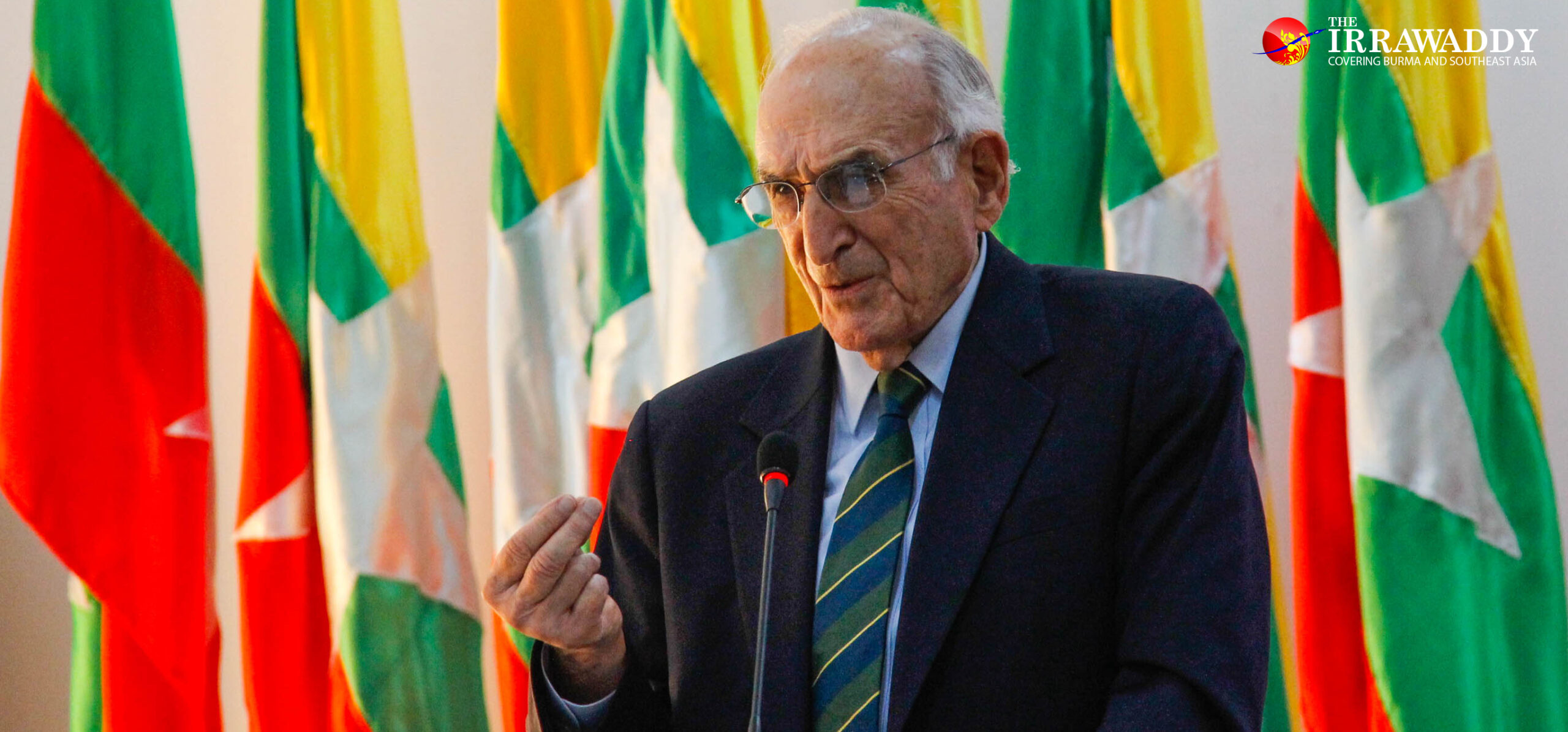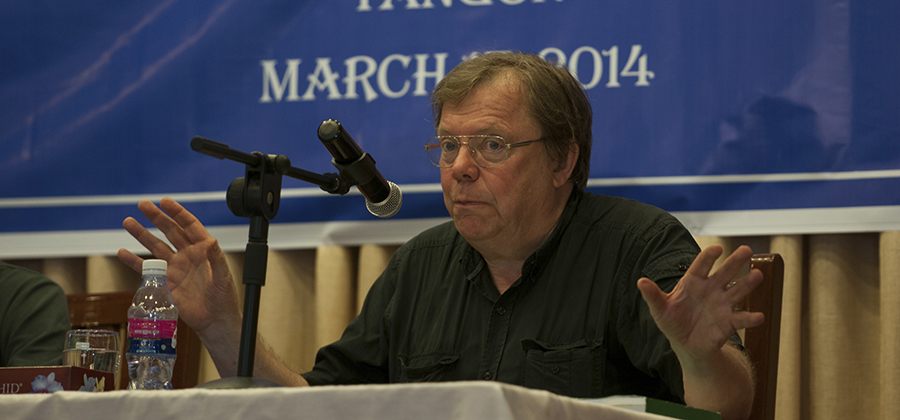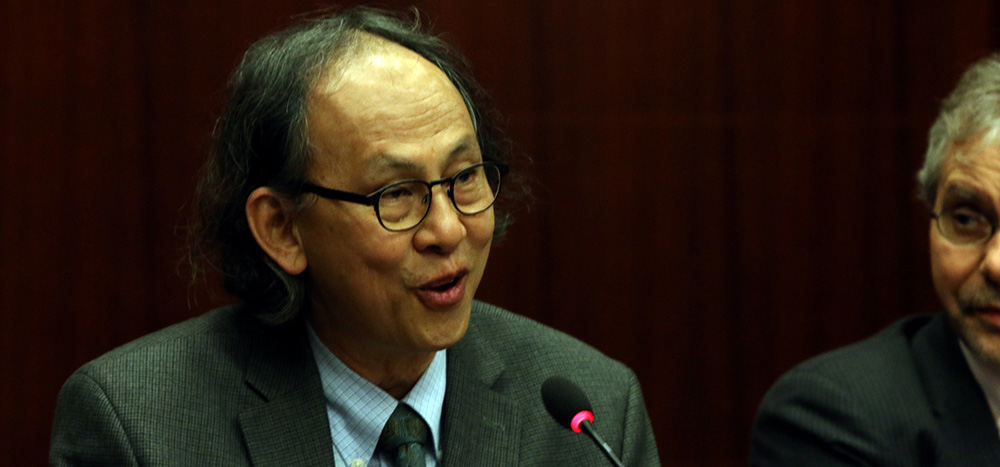
David Steinberg is a specialist on Myanmar, the Korean Peninsula, Southeast Asia and US policy in Asia. He is distinguished professor of Asian Studies emeritus at Georgetown University, and was for 10 years director of Asia Studies there. His works on Myanmar include “Modern China-Myanmar Relations: Dilemmas of Mutual Dependence” (2012, with Fan Hongwei); “Burma/Myanmar: What Everyone Needs to Know” (2010, 2012); “Turmoil in Burma: Contested Legitimacies in Myanmar” (2006); and “Burma: The State of Myanmar” (2001). He occasionally contributes to The Irrawaddy, and here offers his views on issues surrounding the election.
What are your thoughts on Myanmar’s upcoming general election in November?
I think that where voting takes place, it will generally be fair—that is, the votes will be counted properly. But there will be significant areas where because of security or COVID, votes will not be allowed, and these will be in ethnic minority areas, which will undercut their relations with the Bamah majority.
What do you think are the main differences between the November election and the previous ones back to 1990?
There is no comparison with 1990.
Many international observers fear that the November election will not be free and fair, citing disenfranchisements and campaign restrictions. However, on the ground, voters and parties alike are still quite enthusiastic and active. What is your view?
It will be acceptable. These 2020 elections are very important to continue the pattern of elections themselves, for then any future government will have great difficulty in avoiding elections and ruling by decree. Yes, there will be limitations, but overall I expect it will be deemed a reasonable effort.
While ethnic parties are stronger and more active than in 2015, the NLD is still popular. What is your prediction for the election outcome?
I expect the NLD will win with a diminished majority, and ethnic parties will do better than in 2015, but the Bamah majority will hold power.
If the NLD wins enough seats to form the government, what can we expect to see in post-election Myanmar, given the 2008 Constitution and the military’s involvement in politics?
The military has designed a system under the 2008 Constitution in which it will hold the essential power of those aspects of the society it feels protects its core interests: unity of the state; control over the Defense, Home Affairs and Border [Affairs] ministries; a majority on the [National Defense and Security Council]; autonomy of the military in managing its own affairs; and prevention of changes to the Constitution it does not want (assuming there is no split within the military). Relations with the civilian government will continue to be tense, and none of the basic problems of the state will be resolved, alas.

Bertil Lintner has written extensively about Myanmar’s armed conflicts, politics and ethnic strife for nearly 40 years. He was Myanmar correspondent for the Far Eastern Economic Review from 1982 to 2004, and now writes for Asia Times.
He has written several books on Myanmar including “Aung San Suu Kyi and Burma’s Struggle for Democracy”, “The Rise and Fall of the Communist Party of Burma”, “The Kachin: Lords of Burma’s Northern Frontier”, “Land of Jade: A Journey from India through Northern Burma to China” and “Burma in Revolt: Opium and Insurgency Since 1948”. He occasionally writes for The Irrawaddy. Here are his views on the upcoming election.
What are your thoughts on Myanmar’s upcoming general election in November, and what differences can we expect between this and previous ones going back to 1990?
The 1990 and 2015 elections should be seen as referendums, where the NLD stood for the hope for a better future for the country, while in 1990, the National Unity Party (NUP) represented the old order, and in 2015, the Union Solidarity and Development Party (USDP) was the “new” representative of the same old order. It was a “yes or no” kind of vote where all other political parties became irrelevant. There was a third element as well, in 1990, as well as in 2015: the ethnic factor. Ethnic parties did well in 1990, less so in 2015. But this time it’s different. The NLD has lost support among the ethnic minorities and from the urban middle class. This makes the final outcome hard to predict. And even if the USDP does badly, we have to remember that a quarter of all seats in both houses of the Union Parliament as well as local assemblies is reserved for the military.
Many international observers fear that the November election will not be free and fair, citing disenfranchisements and campaign restrictions. However, on the ground, voters and parties alike are still quite enthusiastic and active. What would you say?
I don’t think so. It is, of course, unfortunate that elections have been suspended in several constituencies, primarily in ethnic areas. But, by and large, people seem to be enthusiastic about voting.
If the NLD wins enough seats to form the government, what can we expect for post-election Myanmar given the 2008 Constitution and the military’s involvement in politics?
It would be hard to change the Constitution even if the NLD wins. More than 75 percent of all MPs have to vote in favor of any change of important clauses in the 2008 Constitution and with the military controlling 25 percent, forget about it. And, contrary to what some people think (“It needs only one soldier-MP to change sides”), soldiers are soldiers and they obey orders. They don’t vote individually and in accordance with their conscience.

Priscilla A. Clapp is a former United States diplomat who served as chief of mission and permanent charge d’affaires at the US Embassy in Myanmar from 1999 to 2002. She is currently a senior adviser to the US Institute of Peace (USIP) and the Asia Society. She is a retired minister-counselor in the US Foreign Service.
Clapp is the author of numerous publications on Myanmar and US-Myanmar policy published by USIP, the East-West Center, the Asia Society, the Australian National University, Singapore’s ISEAS and others. She is also an active media commentator.
What are your thoughts on Myanmar’s upcoming general election in November?
My main impression is that there is more tension around this election than the past two, but perhaps I am not close enough to see the real picture. The cancellations in Rakhine State are extremely disappointing, but understandable considering the devastation and continuing conflict on the ground. There seems to be a real danger of voters and election workers in Rakhine being targeted by combatants.
What do you think are the main differences between the November election and the previous ones going back to 1990?
The 1990 election was a prelude to subsequent elections in various ways. The surprise massive win by the NLD in 1990 [later] motivated the USDP to cut the NLD out of the 2010 elections in order to ensure that the USDP could cheat its way to a win equal to that achieved legitimately by the NLD in 1990. The 2015 election just proved why the USDP had good reason to fear competing against the NLD in 2010. The NLD won another landslide and the USDP was marginalized. I expect this pattern will continue in 2020, although the NLD win may not be as huge as in the past. Once a party wins the right to govern, it inevitably does not meet everyone’s expectations. That is an impossible task!
Many international observers fear that the November election will not be free or fair, citing disenfranchisement and campaign restrictions. However, on the ground, voters and parties alike are still quite enthusiastic and active. What is your view?
I expect the elections to be relatively free and fair, despite some unfortunate incidents here and there, and I expect a large turnout. With the military no longer in charge of the process, the possibility of rigged elections or cheating with the vote is much less. The fact that teachers man most of the polls ensures that voters can be confident their ballots are in good hands! However, the continued disenfranchisement of certain groups, like the Rohingya, is terribly unfortunate and detracts from the democratic legitimacy of the elections.
While ethnic parties are stronger and more active than in 2015, the NLD is still popular. What is your prediction for the election outcome?
I see no way that the NLD would not take a majority, even if it is less of a majority than in the past, because elections in Myanmar are still dominated by the unpopularity of the military, and the NLD is the antidote to that. Furthermore, the NLD dominates in the powerful center of the country, where a preponderance of the votes will come from. On the other hand, I think ethnic parties are nonetheless likely to make substantial gains, particularly at the state level, where they can enjoy a greater hand in governance than they would as small minorities at the national level. So watch the state level results. The SNLD, in particular, is showing remarkable political sophistication. Their platform is very impressive in its vision for the country.

Kavi Chongkittavorn is a senior fellow at the Institute of Security and International Studies at Chulalongkorn University in Bangkok. His research interests include US foreign policy toward Southeast Asia, especially Thailand; the future of the Indo-Pacific; and regional security architecture. He spent three decades as a journalist with the English-language daily The Nation from 1984-2013. From 1994-1995 he served as a special assistant to the ASEAN secretary general based in Jakarta. He is now a columnist for The Bangkok Post. He shared his views on the main issues surrounding Myanmar’s 2020 election with The Irrawaddy.
What are your impressions about Myanmar’s upcoming general election in November?
Voters are enthusiastic to give the NLD another opportunity to improve economic and social conditions.
What do you think are the main differences between the November election and the previous ones back to 1990?
First, voters are more knowledgeable than before. They will pick politicians they think can do the job. Second, under the pandemic, voters do not want to risk having a new government without any proven record. At least, with the current government, voters know and understand what … the government policy [has been] and what will come next.
Many international observers fear that the November election will not be free and fair, citing disenfranchisements and campaign restrictions. However, on the ground, voters and parties alike are still quite enthusiastic and active. What is your view?
Politicians want to contest an election with or without restrictions. They know that already, when they enter politics. It will be interesting to watch whether new parties could win some seats or not.
While ethnic parties are stronger and more active than in 2015, the NLD is still popular. What is your prediction for the election outcome?
I think ethnic parties will get more support and votes from their ethnic groups as the peace process continues to drag on.
If the NLD wins enough seats to form the government, what can we expect to see in post-election Myanmar, given the 2008 Constitution and the military’s involvement in politics?
If the NLD forms the next government, the Tatmadaw needs to continue work with the civilian government and hold dialogues for possible constitutional amendments.

David Scott Mathieson is an independent analyst working on conflict, peace and human rights issues. He has worked on Myanmar since 1995, and for 10 years was the senior researcher on Myanmar for Human Rights Watch. He has been conducting election-related research for more than a year ahead of the Nov. 8 polls. Here are his views on the upcoming election.
What are your thoughts on Myanmar’s upcoming general election in November?
Elections are important milestones in any country moving away from decades of authoritarian rule and isolation, and Myanmar has made important progress. Yet there are very worrying caveats to that progress in these elections, amidst a pandemic the NLD government has mishandled, uncertainty about the safety of people coming to vote and the potential for scores of super-spreader transmissions at polling stations in Yangon and elsewhere, the incompetence of the Union [Election] Commission at a senior level, the political interference by senior political figures, especially State Counselor Daw Aung San Suu Kyi, in the planning for the polls, more violence reported than in previous elections, and justifiable anger at the opacity of the election cancellations in Rakhine, Shan and Kachin states. The excitement many people are likely feeling at the opportunity to have their votes count is leavened with fear at catching the virus, and the economic uncertainty and hardships the pandemic have wrought.
What do you think are the main differences between the November election and the previous ones going back to 1990?
These elections are markedly different from previous ones. 1990 was an election conducted in the wake of a massive nationwide uprising that ended years of incompetent Socialist rule, but it also precipitated 20 years of repressive military rule that slowly gathered enough steam to conduct a tightly managed election in 2010 in which many parties were still deterred from contesting. The 2015 elections were a watershed: people voted as much for the NLD as they did against the USDP and the military; it was a repudiation of the Tatmadaw’s [the Myanmar military’s] role in governing the country. However, the NLD government did very little to address the grievances and aspirations of many people who voted for them five years ago. The 2020 elections have to be cast in the light of the disappointment at the unimpressive progress of the government, the general air of high-level meddling in the conduct of the elections, balanced against what is still a very important continual step in democratic consolidation. On a very positive level, the involvement of strong civil society organizations such as PACE [the People’s Alliance for Credible Elections] and many others illustrates a strong commitment to democratic progress in Myanmar, and local-level election officials have been dedicated to conducting free and fair polls, even with an incompetent senior leadership in Naypyitaw. The media has still managed to contribute to accurate reporting on many aspects of the polls. The positive role in preparing for the elections by many people throughout Myanmar must be recognized and applauded, and the commitment by many people to engage in the democratic process.
Many international observers fear that the November election will not be free or fair, citing disenfranchisement and campaign restrictions. However, on the ground, voters and parties alike are still quite enthusiastic and active. What is your view?
Given where many people in Myanmar live, there have been exuberant campaigning events, despite fears of COVID-19 and the limits on public gatherings; many supporters of the NLD have been incredibly active. This is at stark contrast to the extent of cancellations, especially in Rakhine State and parts of Shan State, and the strong feelings of being ruthlessly disenfranchised. Campaigning has still proceeded in many ethnic states, but there appears to be simmering resentment at foul play over the elections by the government and the Tatmadaw. Assessments of the elections have to consider these contrasting experiences. We also have to remember that the one-quarter unelected seats of the Tatmadaw in national and state and regional assemblies [makes] this election a 75-percent exercise, with no progress over the past five years in diluting this military advantage. The Tatmadaw is still an unwelcome squatter in the parliamentary process.
While ethnic parties are stronger and more active than in 2015, the NLD is still popular. What is your prediction for the election outcome?
Given the enormous and widespread popularity of Daw Aung San Suu Kyi and popular support for the NLD in the heartland regions, it is almost a forgone conclusion the NLD will be returned to power—perhaps with a reduced majority, but coming off a resounding landslide in 2015 the NLD will continue its rule. Ethnic parties in Shan, Kachin and Mon will likely do well, but the odds are stacked against them to have more influence in the national Parliament and the states. The NLD will still choose chief ministers and many of the state assemblies have little real power, so even more ethnic seats will be a Pyrrhic victory. The NLD has almost completely neglected the aspirations of the ethnic parties, and failed to pursue genuine national reconciliation, so the election outcome won’t solve the political outcome, of widening political and social divisions.
If the NLD wins enough seats to form the government, what can we expect for post-election Myanmar given the 2008 Constitution and the military’s involvement in politics?
The depressingly likely result of the 2020 elections will be more of the lackluster governance style of the NLD and Daw Aung San Suu Kyi. The last five years has failed to produce any progress on constitutional reform; [there have been] some gains in economic reform but still the specter of corruption, widespread environmental degradation and land grabbing, and the lascivious specter of Chinese infrastructure development looms over the development of the country.
Myanmar now faces a stark future of continued plunder, caught between the Scylla of predatory Chinese expansion or the Charybdis of World Bank-style infrastructure, with many Western donors retreating on promoting people-centered development and instead injecting funds into destructive infrastructure projects that Naypyitaw is more interested in.
The peace process has been one of the most glaring disasters of the NLD, failing to be all-inclusive of groups outside the now discredited Nationwide Ceasefire Agreement [NCA], [with] the rise of an ultraviolent Arakan Army [in western Myanmar] and continued armed resistance in Shan State, and regular fighting even with signatories to the NCA, still hundreds of thousands of internally displaced people, [and] intense restrictions on humanitarian access to people affected by armed conflict, with international donors pitchforking lavish funding into a non-performing process. This renders clear that the State Counselor’s view of reconciliation is predicated on her continued struggle with the Tatmadaw that has been raging since 1990, and not addressing the deeper ethnic divisions in the country. The future for Myanmar is a central heartland where living conditions gradually improve but with reduced rights and an underfunded public health care system, and ethnic states where massive drug production, land grabs, multi-sided armed conflict and increased migration and inter-group tensions will increase.
Elections should actually address these deep fissures, and generate a new class of political leaders beyond the male gerontocracy that run most political parties and key institutions such as the UEC, and the increasingly imperious and disconnected State Counselor. The real future of the electoral progress in Myanmar will hinge on the inclusion and participation of nearly 5 million new voters this year and looking ahead to the 2025 elections and the serious facing up to the issues that continue to divide Myanmar.
You may also like these stories:
Election 2020: The Week in Review
How Are Myanmar’s Ethnic Parties Responding to the Cancellation of Voting in Conflict Areas?
Understanding the Bigger Picture of Myanmar’s Election

















